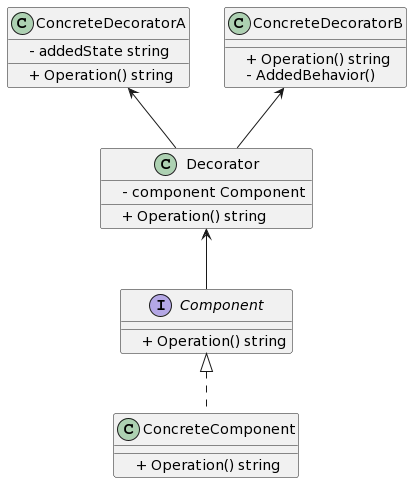1. 什么是装饰器模式
装饰器模式是一种结构型设计模式,它允许动态地向一个对象添加额外的功能,而无需修改对象的代码。装饰器模式通过将对象包装在装饰器类中,实现在运行时添加、修饰或修改对象行为的能力。
2. 装饰器模式的特点和优点
装饰器模式的特点和优点包括:
- 动态扩展对象的功能,无需修改对象代码。
- 符合开闭原则,可动态添加和移除装饰器。
- 可以组合多个装饰器,实现嵌套式的功能扩展。
- 装饰器可以独立于对象被装饰的方式独立变化。
3. 装饰器模式的实际应用场景举例
装饰器模式在实际开发中有许多应用场景,例如:
- 动态添加日志记录功能
- 动态添加缓存功能
- 动态数据校验
4. Golang中的装饰器模式实现
4.1. UML类图

4.2. 示例介绍
在示例中,我们有一个Component接口和一个ConcreteComponent类,它实现了Component接口的方法Operation。
然后我们有一个Decorator类,它也实现了Component接口。Decorator类有一个Component类型的成员变量component。
ConcreteDecoratorA和ConcreteDecoratorB类都继承自Decorator类,并通过重写Operation方法来实现额外的功能。
4.3. 实现步骤1: 定义接口和实现类
type Component interface {
Operation() string
}
type ConcreteComponent struct {}
func (c *ConcreteComponent) Operation() string {
return "具体组件的操作"
}
4.4. 实现步骤2: 定义装饰器
type Decorator struct {
component Component
}
func (d *Decorator) Operation() string {
return d.component.Operation()
}
4.5. 实现步骤3: 装饰器的实现
type ConcreteDecoratorA struct {
Decorator
addedState string
}
func (c *ConcreteDecoratorA) Operation() string {
c.addedState = "New State"
return c.addedState + " " + c.component.Operation()
}
type ConcreteDecoratorB struct {
Decorator
}
func (c *ConcreteDecoratorB) Operation() string {
return "具体装饰器B的操作 " + c.component.Operation()
}
4.6. 实现步骤3: 装饰器的使用
func main() {
component := &ConcreteComponent{}
decoratorA := &ConcreteDecoratorA{}
decoratorA.component = component
decoratorB := &ConcreteDecoratorB{}
decoratorB.component = decoratorA
result := decoratorB.Operation()
fmt.Println(result)
}
5. 装饰器模式和其他设计模式的比较
5.1. 与继承的比较
装饰器模式与继承相比,它可以动态地添加功能而无需修改已有的代码。而继承则是静态的,需要在编译时确定。
5.2. 与静态代理模式的比较
装饰器模式与静态代理模式都可以实现功能扩展,但装饰器模式更加灵活,可以动态添加和移除功能。
5.3. 与动态代理模式的比较
装饰器模式和动态代理模式都可以在运行时对对象进行功能扩展,但装饰器模式是对单个对象进行装饰,而动态代理模式是代理对象与被代理对象之间的间接访问。